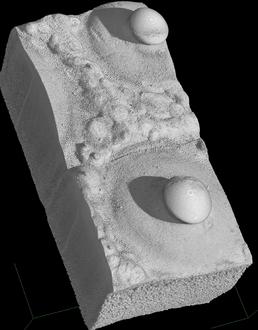µ-VIS Computed Tomography Centre
- Homepage
- http://www.soton.ac.uk/muvis
- Investigators
- Ian Sinclair, Richard Boardman, Dmitry Grinev, Philipp Thurner, Simon Cox, Jeremy Frey, Mark Spearing, Kenji Takeda
µ-VIS: Multidisciplinary, Multiscale, Microtomographic VOLUME IMAGING AT SOUTHAMPTON
The last decade has seen a dramatic enhancement in the technologies available for rapid CT scanning of objects of interest to many scientific disciplines, from rodents to rocks to rockets. Whilst taking high resolution three dimensional images via CT scanning has become almost as rapid as taking a polaroid photograph, there is a price for scientists and engineers using the technique; few are prepared for the enormous volume of information that is produced and the extensive analysis required.
The newly established µ-VIS Centre brings together teams of scientists and engineers that have immediate need of CT imaging with world-leading experts in high performance computing and the art of image processing, along with a suite of advanced, flexible CT imaging hardware. It will be an efficient, multi-disciplinary centre for 3D imaging science, exploiting the latest technologies in cost-effective supercomputing and data handling methods, leveraging Southampton's extensive experience in eScience, unifying and simplifying the interaction between user, instrument and data.
When included with facilities already available at Southampton, the centre will support the entire imaging process for samples as small as an ant’s head, up to a large car engine; from initial experimental concept and training, through data capture and analysis, to new scientific knowledge.
Over 40 academics, drawn from over half of the Schools of the University are committed to this initiative. Four core themes are identified in Engineering, Biomedical, Environmental and Archaeological Science, aligning with Research Council UK priority areas such as Energy, Living with Environmental Change, Nanoscience, and Ageing: Lifelong Health and Wellbeing.
With its training and user outreach components, the centre will support the next generation of application-led scientists and engineers in the opportunities that rapidly evolving 3D imaging technologies present. The centre draws together research interests in both a ‘bottom-up’ (PhDs and post-doctoral scientists performing experiments) and ‘top-down’ (applicants, international advisors and the research group leaders) manner, providing a vibrant focus for interdisciplinary development.
Categories
Life sciences simulation: Biomedical, Developmental Biology, Ecology, Environmental hazards, Evolution, Neuroscience, Systems biology, Tissue Engineering
Physical Systems and Engineering simulation: Biomechanics, Climate, Energy, Materials, MEMS, Metals, Oceanography, Structural dynamics, Tribology
Socio-technological System simulation: Archaeology
Algorithms and computational methods: Distributed computing, FFT, Finite differences, Finite elements, Inverse problems, Multi-scale
Visualisation and data handling methods: Data Management, Database, Surface imaging, Voxel imaging
Visualisation and data handling software: Avizo, Blender, Gnuplot, ImageJ/Fiji, MySQL, Simpleware, VG Studio Max, VTK
Software Engineering Tools: Emacs, Mercurial
Programming languages and libraries: C, C#, Java, Matlab, Python
Computational platforms: .NET, GPU, Linux, Mac OS X, Windows
